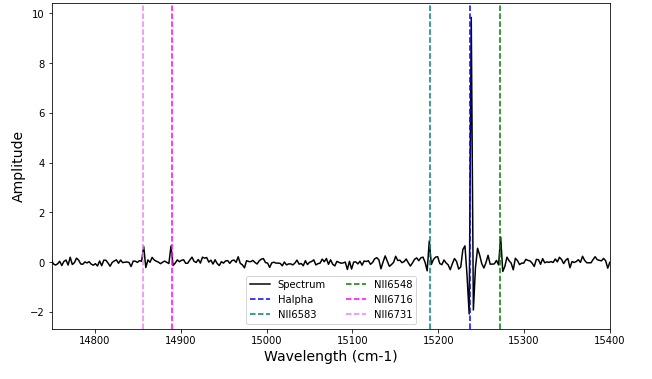Example Synthetic Spectrum
In this example we will create a synthetic spectrum for SN3. This example can be found as a jupyter notebook in “LUCI/Examples/Create-Mock-Spectrum.ipynb”.
# Imports
import sys
sys.path.insert(0, '/home/carterrhea/Documents/LUCI/') # Location of Luci
from LUCI.LuciSim import Spectrum
import matplotlib.pyplot as plt
Inputs
There are a number of inputs we need in order to create a mock spectrum.
They are the following:
lines: List of lines to model (e.x. [‘Halpha’])
fit_function: Function used to model lines (options: ‘sinc’, ‘gaussian’, ‘sincgauss’)
ampls: List of amplitudes for emission lines
velocity: List of velocities of emission lines; if not a list, then all velocities are set equal
broadening: List of broadening of emissino lines; ditto above
filter: SITELLE Filter (e.x. ‘SN3’)
resolution: Spectral resolution
snr: Signal to noise ratio
lines = ['Halpha', 'NII6583', 'NII6548', 'SII6716', 'SII6731']
fit_function = 'sincgauss'
ampls = [10, 1, 1, 0.5, 0.45] # Just randomly choosing these
velocity = 0 # km/s
broadening = 10 # km/s
filter_ = 'SN3'
resolution = 5000
snr = 100
Create Spectrum
This is done with one simple command!
spectrum_axis, spectrum = Spectrum(lines, fit_function, ampls, velocity, broadening, filter_, resolution, snr).create_spectrum()
Then we plot:
plt.figure(figsize=(10,6))
plt.plot(spectrum_axis, spectrum, color='black', label='Spectrum')
plt.xlim(14750, 15400)
plt.xlabel('Wavelength (cm-1)', fontsize=14)
plt.ylabel('Amplitude', fontsize=14)
plt.axvline(1e7/656.3, label='Halpha', color='blue', linestyle='--')
plt.axvline(1e7/658.3, label='NII6583', color='teal', linestyle='--')
plt.axvline(1e7/654.8, label='NII6548', color='green', linestyle='--')
plt.axvline(1e7/671.6, label='NII6716', color='magenta', linestyle='--')
plt.axvline(1e7/673.1, label='NII6731', color='violet', linestyle='--')
plt.legend(ncol=2)
plt.show()
